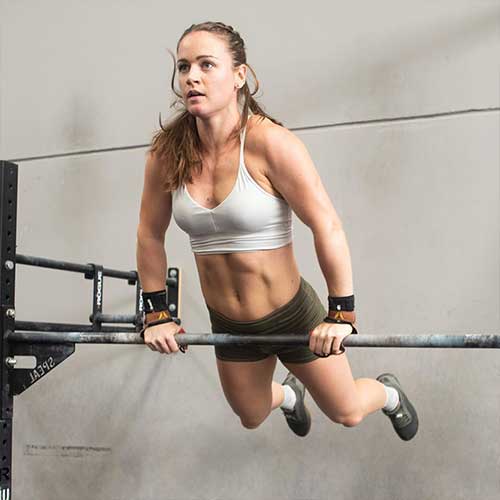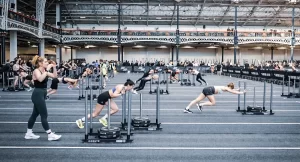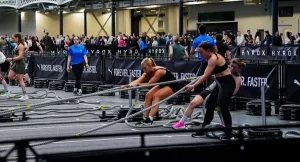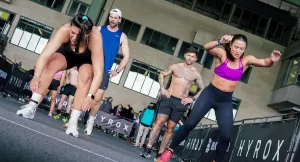How to prepare for a CrossFit competition

Nowadays the steps to qualifying and preparing for an event are pretty standardized. They can be summarized with these 3 stages:
- The qualifiers stage
- Competition prep and tapering
- Competition day/weekend
We will guide you through all these 3 steps to help you make this process as smooth as possible for you, no matter your experience level.
The qualifiers stage
With the rising popularity of the sport and increasing number of athletes looking to partake in competitions most events have introduced a primary qualification step. This stage allows them to select the most competitive athletes out of the field of participants, the selected (=qualified) athletes will move onto compete at the “in person” event.
When following our programming you can rest assured we will progress your fitness to a level that will allow you to always “feel ready” for the majority of qualifiers. Athletes looking to qualify for the highest level competitions (Games or Sanctioned events) may require extra preparation possibly focusing on their weaknesses or simply by tapering volume in the preceding weeks to qualifiers.

Qualifiers all follow a basic structure: after signing up/paying for the competition you will have to register yourself onto a given “online leaderboard platform” (this will vary based on the organizer).
The athlete submits their score onto the platform and most times is required to submit video proof as well for each individual score.
These leaderboard platforms will keep tally of all the athletes scores and through a specific algorithm produce a leaderboard for each division, event and overall ranking.
After the deadline for score submissions a set number of athletes for each division will qualify to the “in person” event.
Our biggest tips for approaching qualifiers
- Don’t underestimate recovery: if you are truly giving your all these workouts will be more taxing than you expect. Make sure you are getting adequate sleep and consuming enough food.
- Take volume into account: if you are performing a qualifying workout that has heavy deadlifts and also happen to have a lot of pulling from the ground movements in your programming it may be wise to scale down on the latter or switch your training days around. Another option when you have multiple qualifiers to perform is to program them into your week based off the rest of your training.
- Study up: different organizers will have different ways of setting up a qualifier. From the scoreboard platform used to the requirements on how to upload video proof of the workout. Additionally ALWAYS make sure you read the movement standard requirements and watch any demo videos if they are released. Trust us you won’t want to redo a workout because you got the filming angle wrong or did a movement without following the prescribed standard.
- Ask for help: don’t be afraid to reach out to your gym buddy or a coach at your box asking for help. Filming a qualifying workout can oftentimes be complicated as you will have to give video proof of all the workout standards (ex. that you are using the correct weight on the barbell or jumping at the right height of box jumps). Plus having someone count your reps and make sure your camera is filming you correctly will make the whole experience less stressful. You’ll be able to focus just on the workout and not the filming or judging part.
- Strategize: strategy in Crossfit can make or break an athlete. Between two individuals with similar fitness levels one can prevail simply based off the strategy they used in a workout. This is particularly important during qualifiers as you don’t have someone next to you to help set a pace. Additionally if on a competition floor the placement of objects is set when doing an online qualifier you get to choose where to keep each element you need in the workout. Transition times become key and to minimize them we recommend setting yourself up to have everything as close as possible. You will also need to consider how you plan to break up your reps, when is it a good time to stay conservative and when you believe you should just go all out.

Competition prep and tapering
After the qualifying stage you will move onto preparing for the real deal event. We have compiled a list of key elements we want you take into consideration when getting ready to compete.
CrossFit
- The workouts: find out what are the workouts that will make up the events.
- Tapering: also known as gradually reducing the volume of training. It will help you recover fully before a more strenuous than usual activity such as a competition.
- Food: food is fuel and you shouldn’t ignore it’s role when preparing for a competition.
- Extras: accommodation, travel and so on.
The workouts
Crossfit competitions are notorious for not releasing the workouts before the actual event, and even when they do it’s usually with very little notice.
That’s of course part of the philosophy of Crossfit itself, and the reason why our training is so varied. But it also implies certain conditions.
Leading up to a competition where you don’t know what will be tested exactly you want to show up rested and recovered yet still comfortable with all movements from the higher skills to the grunt work.
For such reason we have developed a template to help you in the lead up to your competitions. We also want to suggest you keep a close eye on all of the competition’s platforms to keep up with any workouts being released.
Tapering
ONE WEEK OUT
For the majority of competitions we recommend to start tapering from The Progrm 7-10 days before the event.
We have designed a general template you can use to best prepare yourself for the “unknown and unknowable” at CrossFit competitions.
This is an adaptable template; if you know the events, it is important to practice them, unless they will be too demanding!
For example, a workout such as 100 back squats at 100kg for time would not be sensible to test one week out as it will leave you too sore before the competition, however making sure your squat is feeling well prepared before going into the competition will be a good idea…

The structure of this week will be based on your competition starting on Saturday and having had a complete rest day Sunday, obviously adapt as needed.
“Know pain, Know pain”
NOTE:
After your recovery day yesterday, today will be the last “hard” day before the competition. If you are currently on any strength cycles, you will not be following them this week.
The focus of this week is to be feeling strong in the movements, remember if you know any of the workouts, substitute them in where appropriate.
Divide today into 2 sessions and have good long warm-ups for each session.
WARM-UP:
Grease the groove prep day circuit, for quality of movement:
10-20 Air squats
10-20 Thrusters 20/15kg
10-20 Overhead Squat 20/15kg
10-20 Box Jumps 20/24inch
10-20 Burpees
10-20 Push-ups
10-20 Pull-ups
CONDITIONING:
For time:
100 Calorie Row
15m Handstand walk
90 Calorie Assault bike
15m Front rack walking lunge 45/30kg
80 Calorie Row
15m Front rack walking lunge 45/30kg
70 Calorie Assault bike
15m Handstand walk
60 Calorie row
15m Handstand walk…. Continue until you complete 10 Calories.
GYMNASTICS:
30min EMOM: Perform as a circuit (40 seconds of work/20 seconds of rest)
1. Ring support (Muscle up to position)
2. Wall facing handstand
3. Ring dip hold (Muscle up to position)
4. Push-ups (slow controlled, good positioning)
5. Hollow body hold
6. Arch body hold
WEIGHTLIFTING/STRENGTH:
Moderate CrossFit Total – do not attempt a PR today!
Use this session to build to a heavy single in Squat, Strict press and Deadlift. Each movement should be heavy but easy, no sticking points.
NOTE:
This is the first day of just 1 session per day.
Take a long time to work through the weightlifting warm-up, before building to a heavy single for the day – do not attempt a PR today!
For the conditioning, you don’t need to go very hard, just get warm and breathing, if you don’t have a SkiErg – run.
WARM-UP:
Grease the groove prep day circuit, for quality of movement:
- 10-20 Air squats
- 10-20 Thrusters 20/15kg
- 10-20 Overhead Squat 20/15kg
- 10-20 Box Jumps 20/24inch
- 10-20 Burpees
- 10-20 Push-ups
- 10-20 Pull-ups
CONDITIONING:
20 minutes SkiErg or Row.
At the start of each minute perform 5 burpees
WEIGHTLIFTING/STRENGTH:
- OHS Complex
Performed with an empty barbell; two sets of five reps in the three different versions. These are: (1) down slow, up fast, without pause in the bottom position; (2) down slow, up fast but with a three second pause in the top- and bottom position; (3) 1,5’s. No pause in the bottom position but a pause in the top between reps. - Snatch warm-up f. the ground
Two sets of three reps in A, B, C, D, E. Be sure to use a large plate, and not the small metal plates, to get the right distance from the floor. Three seconds pause in the catch position in C, D.
A. Snatch Pulls. B. Muscle Snatch. C. Power Snatch. D. Deep Power Snatch. E. Snatch with a three second pause in the bottom position.
Draw a line with chalk and make sure that you are not jumping forward. Don’t check the line as you land but when you are in the top position. First you lift then you check. - Snatch –
- Build to you a easy but heavy single in full Snatch.
- Front Squat Complex
Performed with an empty barbell; two sets of five reps in the three different versions. These are: (1) down slow, up fast, without pause in the bottom position; (2) down slow, up fast but with a three seconds pause in the top- and bottom position; (3) 1,5’s. No pause in the bottom position but a pause in the top between reps. - Clean & Jerk warm-up
- Two sets of three reps of muscle cleans w. a three second pause in the top position.
- Two sets of three reps of power clean w. a three second pause in the catch.
- Two sets of three reps of power clean w. a three second pause in the catch followed by a front squat of the first version (down slow, up fast, no pause in the bottom position).
- Two sets of three reps of power clean w. a two second pause in the catch followed by a front squat of the first version (down slow, up fast, no pause in the bottom position) and after the last clean three split jerks w. a three second pause in the split.
- Two sets of three reps of power clean w. a one second pause in the catch followed by a front squat of the first version (down slow, up fast, no pause in the bottom position) and after the last clean three split jerks w. a three second pause in the split.
- Two sets of three reps of power clean without the pause in the catch followed by a front squat of the first version (down slow, up fast, no pause in the bottom position) and after the last clean three split jerks w. a three second pause in the split.
- Clean and Jerk –
- Build to an easy but heavy single in Clean and Jerk.
NOTE:
The CrossFit workout today is to make sure the overhead position is feeling good and ready for anything on Saturday.
WARM-UP:
Grease the groove prep day circuit, for quality of movement:
10-20 Air squats
10-20 Thrusters 20/15kg
10-20 Overhead Squat 20/15kg
10-20 Box Jumps 20/24inch
10-20 Burpees
10-20 Push-ups
10-20 Pull-ups
CROSSFIT:
For quality, not time:
Ascending turkish get-up ladder, left arm then right arm:
8kg – 12kg – 16kg – 20kg – 24kg – 28kg – 32kg
Directly into 4 rounds:
18 GHD sit-ups
18 Overhead walking lunges 24/16kg KB (9 each leg)
60 Double-unders
CROSSFIT:
3 Rounds For Time:
400m Run
20 Thrusters 40/30kg
10 Pull-ups
2 minutes rest
ACCESSORY:
3 rounds:
Perform without dropping from the bar:
4-8 Top half TTB
4-8 Bottom half TTB
4-8 Strict TTB
Rest as needed between rounds
NOTE:
This is a modified version of a workout we used before the 2016 Regionals.
It takes around 60 minutes, the focus of this workout is not to go out hard but to get each of the movements feeling smooth. “Grease the groove”
Walk between exercises, put yourself in a strong mindset.
If you know some of your competition workouts, then obviously substituting some of the movements to fit better is sensible.
Grease The Groove Regional 2016 – Modified:
For quality of Movement:
5-4-3-2-1 Snatch:
(Males up by 10kg Females 5kg build to the same weight as Training 2)
5 rounds:
2 MU
4 HSPU
8 KB snatch 32/24kg
1 round:
52 wall balls 9/7kg, 10ft target.
26 pull-ups
Rest 1 Minute
28 pistols (14 each leg)
15 Power Cleans 50/35kg
1 round:
400m run
40 GHDs
7 DL (Choose an unbroken weight)
1 round:
1km assault bike
30m HSW
5 OHS (Choose an unbroken weight)
500m row
20 burpee box jump over 24/20”
3 OHS
1 round:
27 Thrusters 45/30kg
4 Rope Climbs 15ft
NOTE:
Go through your checklist you made on Sunday and make sure you have everything you need.
Often this is a travel day for people, so make sure you keep well hydrated on the trip, also make sure you have food prepped. You don´t want to get to a service station or be on the plane and have no option but to eat bad food.
Try not to stay out late, even though there may be other athletes/friends/family try to take yourself away and get to sleep or rest early.
Make sure you have travel plans for the morning, so you wont be rushing to the venue.
GO OFF FEEL:
10 – 15 minutes:
Run/walk/jog/bike/swim this is just something to get moving after your travels.
WARMP-UP:
Grease the groove prep day circuit, for quality of movement:
10-20 Air squats
10-20 Thrusters 20/15kg
10-20 Overhead Squat 20/15kg
10-20 Box Jumps 20/24inch
10-20 Burpees
10-20 Push-ups
10-20 Pull-ups
FINAL PREPARATIONS:
10 minutes movement:
If any of the movements felt sore or stiff then spend 10 minutes mobilising, sit on a foam roller if you feel you need to, this is the time to feel comfortable.
Finish off the session by visualising the competition day, be as specific as you can, you wake up, have breakfast, get to the venue, warm-up for the first event, if you know the workouts go through them and how they will feel if you don´t it is no reason to worry just take your self through the day, feeling how well prepared you are for the competition.
Food
Nutrition is always a key aspect of sports performance.
If on one hand you will want to fuel yourself in the best way possible on the other we do NOT recommend you try any new supplements or foods you have never had before.
Additionally we would highly recommend to stay away from any raw foods or foods that could have possibly gone bad during the duration of the competition and the week leading up to it.
It may sound stupid but the last thing you want is to get food poisoning a day before you step out on the floor.
Also take in account where you will be getting your food from during the weekend. If you are staying at an hotel you may want to meal prep some meals in advance to take with you to the venue.
Just make sure your room has a mini fridge to stock them in the meantime. It is a rookie mistake to be as best physically prepared as you can be and then underperform on Game Day due to poor food prep.
We recommend you stick to foods you are used to and pack LOTS of snacks.
Most athletes won’t have much of an appetite during the day so it’s easier to get calories in through smaller calorie dense meals. Even if you’re not hungry you need to consume enough energy to help you recover and prepare for the next events.
If you really can’t handle the idea of eating make sure you at least consume a carbohydrate and protein shake after each event. Stay away from food with too much fat in them as they will slow down digestion.
Finally stock up on water. Some venues may offer free water fountains, if that is the case bring a couple of reusable bottles and keep filling them up. Otherwise consider making a stop to the closest supermarket a buying a pack or two of bottled water, you’ll also avoid spending extra money on overpriced water at the venue.
Especially in the summer dehydration can have a huge impact on performance and can lead to more serious conditions. It is critical that you always have water with you.
Extras
Often overlooked by rookies, don’t make their same mistakes.
Accomodation and transportation
These are pretty straightforward: if the venue where you’ll be competing isn’t easily accessible from where you live you will have to consider traveling options and where to stay.
Whatever is your choice of transportation avoid pushing your travel to the last minute, you want to avoid any stressors including scenarios of missed last call trains or flights.
Regarding accommodation the options are endless, from hotels to Air-BnBs. Although your budget will probably draw the final decision, make sure to consider how far out you will be from the venue and how you can reach it transportation wise.
Additionally, as we already talked about, plan out your “food strategy”. Take in account what kitchen appliances you will have access to, if any, and plan accordingly.
Training gear
For this one we recommend writing a checklist: don’t be the athlete that rocks up to the competition without their weightlifting shoes, belt, double under rope or whatever it may be.
Just spend some time writing a simple checklist so when you pack your bag you are sure that you have everything.





